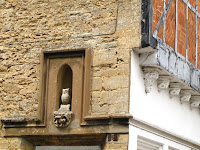 In contrast to last weekend's perfect weather, the forecast for today was extremely volatile, with thunder storms waking us up, and nowhere totally free of showers today. But by mid-morning it had cleared up to bright sunshine, so we decided to join the Oxfordshire MG owners for their outing at the Cotswolds Wildlife Park.
In contrast to last weekend's perfect weather, the forecast for today was extremely volatile, with thunder storms waking us up, and nowhere totally free of showers today. But by mid-morning it had cleared up to bright sunshine, so we decided to join the Oxfordshire MG owners for their outing at the Cotswolds Wildlife Park.We enjoyed several hours of warm sunshine and photographed their wide range of animals, which included most of the favourites for zoos,
 and a few new animals we hadn't seen before, like a very 'energetic' sloth. There was also quite a good selection from NZ to remind us of home. The zoo is in the grounds of a stately home, and they had an entirely new use for a walled garden. Unlike yesterday's colourful display of flowers, they had a great display of animals including some very colourful birds. One double door enclosure contained many ring tailed lemurs. They posed very happily while photographers, fascinated by their antics, clicked away.
and a few new animals we hadn't seen before, like a very 'energetic' sloth. There was also quite a good selection from NZ to remind us of home. The zoo is in the grounds of a stately home, and they had an entirely new use for a walled garden. Unlike yesterday's colourful display of flowers, they had a great display of animals including some very colourful birds. One double door enclosure contained many ring tailed lemurs. They posed very happily while photographers, fascinated by their antics, clicked away.

The MGs set off on a 30-mile run through some of the best Cotswolds' towns,
 just as an dark and ominous weather front moved in. So there was no chance for photos from the open top, as most drivers surrendered to the elements and put their tops up as the rain got progressively heavier and, in spite of the forecast suggesting that the rain would have moved through by 3 pm, it was on and off showers and heavy rain all the way home.
just as an dark and ominous weather front moved in. So there was no chance for photos from the open top, as most drivers surrendered to the elements and put their tops up as the rain got progressively heavier and, in spite of the forecast suggesting that the rain would have moved through by 3 pm, it was on and off showers and heavy rain all the way home.




















































